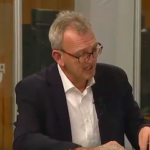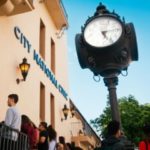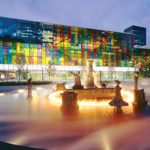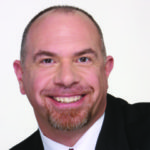
When the new Global Center for Health Innovation opened in October 2013, it capped the evolution of Cleveland into one of the world’s preeminent locations for medical meetings. The building’s four-story glass wall overlooks the grass roof of the equally new Cleveland Convention Center, which opened just three months before the Global Center, in the heart of downtown.
The development of Cleveland as a medical innovation hub dates back to the 1920s and ’30s, when both Cleveland Clinic and University Hospitals opened their doors in the University Circle neighborhood. Located 15 minutes from the city’s urban core, University Circle encompasses a concentrated wealth of health-care and education institutions, including Case Western Reserve University and the Louis Stokes VA Medical Center. Together, all of these facilities make up one of the largest medical-research campuses in the world.
During a recent visit hosted by Destination Cleveland, Convene explored a city whose medical-meetings infrastructure is only getting bolder.
DAY 1: University Circle
Our trip began over lunch with Aram Nerpouni, president and CEO of BioEnterprise, an economic-development accelerator focused on building the biomedical industry in Northeast Ohio and attracting investment, companies, and talent to its medical and health-care sector. In the first five years after its founding in 2002, BioEnterprise and its partners secured more than $500 million in early-stage funding to develop new biomedical-industry businesses. In the last five years, Northeast Ohio has brought in $1.5 billion. “The new Global Center is really a microcosm of the Cleveland biomedical industry,” Nerpouni said. “It’s a symbol of our world-class leadership in biomedical innovation.”
From there we ventured to the exceptionally well-organized Louis Stokes Cleveland VA Medical Center in University Circle. The VA has 18 satellite clinics providing care for more than 115,000 veterans in northern Ohio, many of whom find it challenging to visit the clinics in person. Because of that, the Cleveland VA has become the country’s leader in telehealth and telemedicine — the health-care equivalent of virtual meetings, with patients engaging with their doctors via video consultations when they don’t require direct care.
Planners can arrange tours of the VA to see how a government-operated health system has found itself at the cutting edge of medical technology in America. And guess who’s leading the demand for telehealth? “Millennials don’t want to drive and sit in a waiting room or parking lot,” said Brook Watts, M.D., an internal-medicine physician at the Cleveland VA. “They want to do things via telehealth. Millennials want to take a picture of something on their arm on their phone, and email it to a dermatologist who will write back in an hour and tell them what to do about it.”
Next, we drove a few minutes to Case Western Reserve University, which works closely with University Hospitals and Cleveland Clinic to share resources and knowledge throughout the business community and with business travelers. Case School of Engineering’s Think[box] business incubator connects university faculty, economic-development experts, and local startups to brainstorm ways to drive innovation in the 21st-century knowledge economy. Think[box] is free and open to the public, and this fall is moving into a new, state-of-the-art building on campus that will be able to host events for up to 250 people. Planners can tap a wealth of medical-engineering experts as speakers through Case Western Reserve University.
DAY 2: The Centers
The interconnected Cleveland Convention Center and the Global Center for Health Innovation form a purpose-built, high-tech complex for medical professionals to meet and share knowledge. The complex offers 1 million square feet of event space, 35 meeting rooms, and a 32,000-square-foot, column-free ballroom. The convention center’s entrance is above ground, facing nearby Lake Erie. As you enter, the space shifts down one level underground, but natural light filters throughout most of the building. The convention center is attached to both the Global Center and the new Hilton Cleveland Downtown, opening in 2016.

The Global Center is an enormous box flooded with natural light, with four floors of suites surrounding the interior courtyard. The suites are home to world leaders in medical tech, including Siemens, Cisco, Philips, GE Healthcare, Cleveland Clinic, MetroHealth, and other organizations that collaborate on site with each other and with visiting meeting planners.
In the Cisco suite’s TelePresence Room — a high-resolution, multiple-camera videoconferencing space — we spoke virtually with Christie Marquez, a health-care practice adviser at Cisco. “We’re not, as we’re sometimes called, just ‘the plumbers’ that provide Internet pipes and wireless connectivity,” Marquez said. “We connect people, we connect devices, we connect and process data, and frankly, we’re really good at it.”
Meeting planners with events at the Global Center often contact the in-house sales team to inquire about speakers for their program. The sales team then reaches out to tenants like Cisco where appropriate. “Cisco is happy to participate,” Marquez said, “because we’re experts in telecommunications, which supports everything happening in telemedicine, for example.”
A few suites away sits Cleveland Clinic, with dozens of models of health-tech devices and 18 video installations to educate visitors on how the physician-led organization serves as a model for 21st-century health care. “We do a great job of using the Global Center in partnership with meeting planners, whether we’re hosting tours or receptions, where we can also have buses continuously running to the Cleveland Clinic for tours,” said Mary Curran, senior director of executive administration for the Cleveland Clinic Foundation. “I mean, if you come for a convention and you really want to see how the new GE equipment works in a cardiac cath lab, we can show you that, and it all starts here in the Global Center.”
Occupying the entire top floor of the Global Center is the Healthcare Information & Management Systems Society (HIMSS), a nonprofit organization that brings together thousands of companies in the international medical-IT industry — one of the fastest-growing verticals in the health sector. “When you come to this floor, you learn about what’s happening throughout the global medical and health-care industries,” said John Paganini, HIMSS’s senior manager of interoperability initiatives. “This building is very synergistic. It’s really a showroom for sharing knowledge where we can create very customized programming and content for medical meeting professionals.”
DAY 3: Health-Tech Corridor
On our final day in Cleveland, we explored the 3.5-mile urban landscape between the Global Center and University Circle, branded as the Cleveland Health-Tech Corridor (HTC). Due to the massive growth in high-tech medical companies in Cleveland over the last decade, the 1,600-acre HTC is developing into a cool, rejuvenated, post-industrial district with a high concentration of thought leaders and potential convention speakers. And connecting it all, a $5-million, 100-gigabit Internet backbone offers the fastest possible Internet speeds for public use in the United States.
Showing the political will to develop the advanced industry district, Cleveland has invested $70 million into the HTC over the last five years. “Cleveland is one of the leaders in the country in terms of gigabit infrastructure, because we’re anticipating demand in the future,” said Jeff Epstein, the HTC’s director. “The interesting thing about the Corridor is the nature of collaboration it’s created. When you start to link all of the assets, it’s really fascinating, because this package is creating a holistic laboratory of amazing innovation.”
Epstein escorted us to a few venues in the HTC, including the Baker Electric Building, which in the early 1900s served as the country’s first electric-car research and manufacturing facility. Today, the space is home to companies like Simbionix, which provides simulation, training, and education solutions for medical professionals.
Our final stop in the HTC was Cleveland HeartLab, which neatly summed up the city’s value proposition for medical meetings. CEO Jake Orville put everything in context for us, identifying the three factors that differentiate Cleveland as a medical-meetings hub: access, collaboration, and a bit of a chip on the shoulder. First, planners have unmatched access to Cleveland’s world-class medical brain trust. Second, area companies understand that to compete against cities like San Francisco and Boston, they have to work together better than everyone else. And finally, locals are adamant that their medical infrastructure can compete with anyone else’s in the world, so they work that much harder to prove it.
“I’ve lived in Boston, I’ve lived in Southern California, I’ve lived in Chicago, and I wanted to start a company personally,” Orville said. “I went to San Francisco. I met with their tech transfer offices. We went to the University of Chicago, we went to Harvard Partners, and someone said, ‘Go to Cleveland.’ The second you step in this town, you feel instant collaboration. They know you’re here, they want you here, they like that you’re here.
“You also get instant access. Everyone says, ‘Where do you want to go, who do you want to go see, and how can I help you?’ So that’s why I’m here, personally, and after six years living here, that spirit of access and collaboration is only accelerating.”



